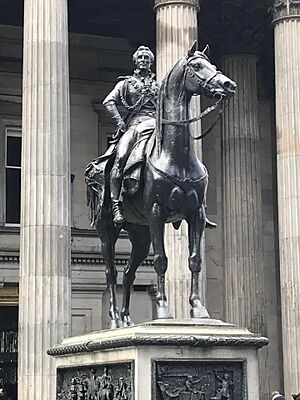Equestrian statue of the Duke of Wellington, Glasgow facts for kids
The equestrian statue of Arthur Wellesley, 1st Duke of Wellington in Glasgow, Scotland, is a famous landmark. It stands outside the building now known as the Gallery of Modern Art, Glasgow. This statue is well-known for often having a traffic cone placed on its head!
The statue was made by an Italian artist named Carlo Marochetti. It was put up in 1844. People helped pay for it to celebrate the end of the long French Revolutionary Wars and the Napoleonic Wars in 1815. Since at least the 1980s, people have traditionally put a traffic cone on the Duke's head. This statue is a very important historical sculpture, listed as Category A.
Contents
The Famous Statue
The statue shows the Duke of Wellington riding his favorite horse, Copenhagen. The Italian artist Carlo Marochetti created it. It was put in place in 1844. This statue is considered a Category-A listed monument. This means it is a very important historical artwork.
The Traffic Cone Tradition
The statue has become famous because people often put a traffic cone on its head. This tradition has continued for many years. Many people think it shows the funny side of the local people. It is believed to have started around the 1980s.
Efforts to Stop the Cones
In 2005, Glasgow City Council and the police asked people to stop putting cones on the statue. They said it caused small damage to the statue. They also worried about people getting hurt trying to place a cone.
In 2013, the Glasgow City Council suggested a plan to fix the statue. This plan would cost about £65,000. Part of the idea was to make the statue's base, called a plinth, much taller. They wanted to raise it to more than 6 feet (1.8 meters) high. This was meant to stop all but the most determined people from putting cones on it.
The council estimated that removing cones from the statue cost £100 each time. This could add up to £10,000 every year. However, many people were against these plans. An online petition to save the cone received over 10,000 signatures. Because of this, the council stopped their plans. An art group called National Collective even organized a rally to support the cone.
In 2015, Glasgow City Council tested new CCTV camera software. This software, worth £1.2 million, could automatically spot people putting cones on the statue. It worked!
Special Cones for Events
The cone on the statue often changes for different events.
- In 2011, the travel guide Lonely Planet listed the statue as one of the "top 10 most bizarre monuments on Earth."
- During the 2012 Summer Olympics, a gold-painted cone was placed on the statue. This celebrated Scotland's part in Team GB's many gold medals.
- A copy of the statue, with a cone, appeared at the 2014 Commonwealth Games opening ceremony. A gold cone was then put on the real statue to mark the games' success.
- In 2014, a "Yes" cone and a flag were added to support the 2014 Scottish independence referendum.
- On Brexit Day (January 31, 2020), people who supported Europe put a cone painted like the EU flag on the statue.
- During the COVID-19 pandemic, the statue wore a cone and a blue surgical mask. This showed how the pandemic affected the country.
- In March 2022, a cone with the colors of the Ukrainian flag was added. This showed support for Ukraine against Russia's invasion.
- In June 2023, the artist Banksy said the statue was his "favourite work of art in the UK." This was to promote his art show at the Gallery of Modern Art. A climate change group then put a cone with their logo on the statue. They asked Banksy to support their cause.
See also
 In Spanish: Estatua de Wellington para niños
In Spanish: Estatua de Wellington para niños


